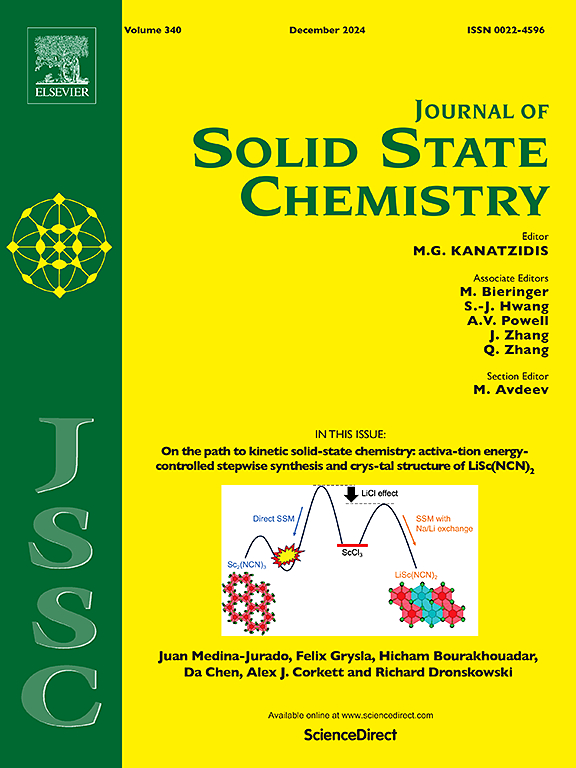Enhancement of the energy storage and electrocaloric effect performances in 0.4 BCZT–0.6 BSTSn medium-entropy ceramic prepared by sol-gel method
IF 3.2
3区 化学
Q2 CHEMISTRY, INORGANIC & NUCLEAR
引用次数: 0
Abstract
Nowadays, advanced dielectric ceramic capacitor-based electrostatic energy-storage science and technology are frequently employed in pulsed power systems. Based on the traditional polycrystalline ferroelectric Ba0.85Ca0.15Zr0.10Ti0.90O3, the 0.4 Ba0.85Ca0.15Zr0.10Ti0.90O3 –0.6 Ba0.9Sr0.1Ti0.9Sn0.1O3 medium-entropy material with good energy storage and electrocaloric effect performances is designed and synthesized by sol-gel method. The structural, dielectric, energy storage and electrocaloric effect properties of the prepared sample were studied. The findings demonstrate that the 0.4 Ba0.85Ca0.15Zr0.10Ti0.90O3 –0.6 Ba0.9Sr0.1Ti0.9Sn0.1O3 ceramic simultaneously has a significant recoverable energy storage density of 255.4 mJ/cm3, an efficiency of 67.9 %, a large electrocaloric effect temperature change of ΔT = 1.36 K, and a high ξmax of 0.453 K mm/kV under a low electric field of 30 kV/cm. Moreover, excellent temperature stability (40–120 °C) of the recoverable energy storage Wrec (less than 10 %) was achieved in the investigated sample 0.4BCZT-0.6BSTSn. This study demonstrates that the 0.4BCZT-0.6BSTSn ceramic is a promising candidate for solid-state cooling and energy storage dielectric ceramics through exploring medium-entropy composition.

溶胶-凝胶法制备0.4 BCZT-0.6 BSTSn中熵陶瓷,增强其储能和热效应性能
目前,基于介质陶瓷电容器的先进静电储能科学技术被广泛应用于脉冲电源系统中。在传统多晶铁电材料Ba0.85Ca0.15Zr0.10Ti0.90O3的基础上,采用溶胶-凝胶法设计合成了具有良好储能和热效应性能的0.4 Ba0.85Ca0.15Zr0.10Ti0.90O3 -0.6 Ba0.9Sr0.1Ti0.9Sn0.1O3中熵材料。研究了制备样品的结构、介电性能、储能性能和热效应性能。结果表明,在30 kV/cm的低电场下,0.4 Ba0.85Ca0.15Zr0.10Ti0.90O3 -0.6 Ba0.9Sr0.1Ti0.9Sn0.1O3陶瓷同时具有显著的可回收储能密度(255.4 mJ/cm3)、效率(67.9%)、较大的热效应温度变化(ΔT = 1.36 K)和0.453 K mm/kV的高ξmax。此外,在所研究的样品0.4BCZT-0.6BSTSn中,可回收储能Wrec具有良好的温度稳定性(40-120℃)(小于10%)。本研究通过对介质熵组成的探索,证明了0.4BCZT-0.6BSTSn陶瓷是固态冷却和储能介质陶瓷的理想候选材料。
本文章由计算机程序翻译,如有差异,请以英文原文为准。
求助全文
约1分钟内获得全文
求助全文
来源期刊

Journal of Solid State Chemistry
化学-无机化学与核化学
CiteScore
6.00
自引率
9.10%
发文量
848
审稿时长
25 days
期刊介绍:
Covering major developments in the field of solid state chemistry and related areas such as ceramics and amorphous materials, the Journal of Solid State Chemistry features studies of chemical, structural, thermodynamic, electronic, magnetic, and optical properties and processes in solids.
 求助内容:
求助内容: 应助结果提醒方式:
应助结果提醒方式:


